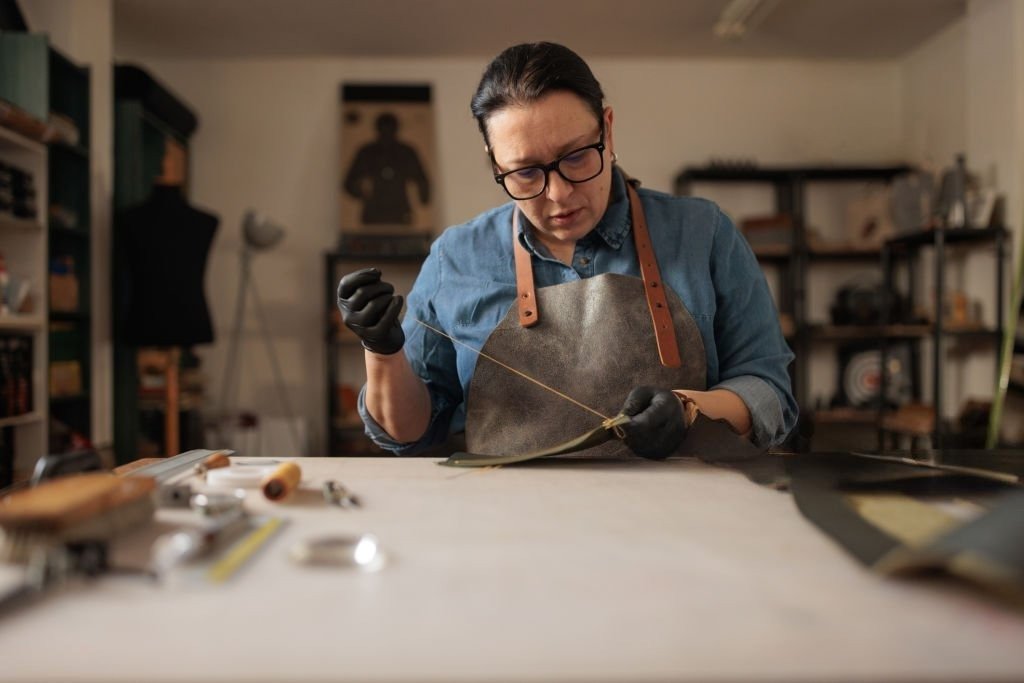No products in the cart.
How to Clean and Oil Your Leather Apron Like a Pro in 2025
Let me guess you finally got your hands on that beautifully rugged leather apron. Maybe it was a gift. Maybe you treated yourself after a big project. Either way, you probably noticed something after a few uses: leather doesn’t just clean itself. That scratch? That oil spot? They don’t vanish magically. And if you’re anything like me, the last thing you want is to ruin something so sturdy, stylish, and practical just because you didn’t give it the care it deserves.
So here’s the deal: leather needs attention. It’s durable, yes, but also sensitive to water, heat, and grime. In this guide, I’ll walk you through everything you need to clean and oil your leather apron the right way no fluff, no outdated tips. By the end, you’ll know how to keep your apron looking sharp and lasting for years.
Leather Apron Care Has Changed
We’re not in 2010 anymore. Leather goods today, especially workwear like aprons, are made with more diverse finishes and treatments than ever before. Some are tanned with vegetable oils, others have synthetic sealants. That means your old method of slapping on some neatsfoot oil and hoping for the best? Yeah, it might do more harm than good.
Many modern aprons come with eco-conscious finishes that can be damaged by traditional conditioners or soaps. Plus, with the rise of artisanal and small-batch leather makers, you’ve got more variety than ever, but also more reasons to clean smart. Your apron’s care needs to evolve with the times. Let’s break down the most effective routine that respects your leather and your effort.
The 5-Step Leather Apron Care Routine
Step 1: Dust It Off and Test First
Before diving into fancy conditioners or cleaners, start simple. Dust, sawdust, and crumbs collect fast and dull the surface. Dusting removes surface dirt and keeps it from embedding during the cleaning process.
Spot testing any cleaner or conditioner is essential. With so many finishes and treatments, one wrong move can permanently alter your apron’s color or feel. Waiting a day for a test patch is smarter than replacing a ruined apron.
If the cloth comes away clean and your test patch holds up, you’re good to move forward.
Step 2: Clean It Without Stripping the Life Out of It
Once the dust is handled, it’s time to clean off grime and stains. Harsh soaps or scrubbing too hard can damage leather. Use pH-balanced cleaners and soft cloths to gently clean the surface without stripping away oils.
Aggressive cleaning is one of the main causes of premature wear. Stick with safe products and light pressure.
| Stain Type | Fix |
| Oil/Grease | Baking soda overnight |
| Ink | Leather-safe alcohol pads |
| Food stains | Castile soap + gentle sponge |
Let the apron air dry naturally. Heat and sunlight can warp leather.
Step 3: Pick the Right Conditioner
Conditioning keeps leather supple and prevents cracking. But not all conditioners are created equal. Match the product to your lifestyle and apron use. A chef and a carpenter won’t need the same leather care.
Many conditioners on the market are meant for boots or bags not aprons. Avoid anything that clogs the surface or leaves residue.
| Conditioner | Best For | Cons |
| Neatsfoot oil | Stiff or old leather | May darken color |
| Mink oil | Outdoor/workshop aprons | Can feel greasy if overused |
| Dubbin | Industrial use, heavy-duty | Too heavy for soft finishes |
| Beeswax blends | Light daily use, chef’s aprons | Needs reapplication often |
Start small. Use a cloth or fingers to apply in circles. Less is more. Over-conditioning causes a build-up.
Step 4: Oil It Like a Pro
Oiling adds moisture, shine, and flexibility. It complements conditioning, especially in dry climates. This step helps preserve structure and softness over time.
Here’s how to oil properly:
- Lay your leather apron flat on a clean towel.
- Add a few drops of oil to a soft cloth.
- Rub in circles from top to bottom.
- Let it sit for 30 minutes.
- Buff gently with a dry cloth.
Warmth helps absorption. If needed, place the apron in a warm room before applying thicker products like beeswax.

Step 5: Store It Right (And Safe)
Don’t let poor storage undo your work. Folding, crumpling, or leaving leather in a damp space shortens its lifespan. Proper storage keeps your apron smooth and protected.
Storage checklist:
- Hang on a padded hanger
- Avoid folding
- Keep in a dry, ventilated place
- Wrap in breathable cloth for long-term storage
Also remember: oils are flammable. Store oiled aprons away from heat or open flames.
Bonus Section Stain Rescue Kit
Accidents happen. A good stain kit keeps you ready. This quick rescue routine can save your apron from permanent damage.
Keep on hand:
- Cornstarch
- Castile soap
- Soft brushes
- Cleaning pads
- Beeswax cream
Steps:
- Apply cornstarch overnight for oil.
- Brush gently the next day.
- Spot clean with diluted soap.
- Let dry and recondition.
Expert Advice & Real Lessons
Leather pros agree: prevention beats panic. One craftsman compared leather care to hydration. “Only conditioning when it cracks is like only drinking water when you’re dizzy.”
Online communities now prefer beeswax over older oils. A 2025 Reddit poll showed 60% of users found beeswax gave better results than neatsfoot. Each leather type behaves differently. Test and learn what works best for your use case.
Final Thoughts
Caring for your leather apron isn’t complicated it’s just about building the right habits. Think of it as part of your craft, not a burden. From daily dusting to using the right cleaners and conditioners, each small step adds years to your apron’s life and character. Light oiling now and then, plus proper storage, helps it resist cracks, stains, and fading.
Don’t wait for visible damage to start a care routine. Keep a basic stain kit within reach, apply conditioner sparingly but consistently, and avoid over-washing. Leather loves a little attention, and the payoff is huge it’ll age beautifully and stay reliable no matter how much work it sees.
So give your apron the care it deserves. Try this simple routine and see the difference yourself. And if you’ve got a care trick that works wonders, drop it in the comments. Let’s learn from each other one apron at a time.
FAQs
How often should I condition a leather apron?
Every 3–4 months, or when stiffness begins.
Can I use olive or coconut oil?
No. They spoil over time and damage leather.
What if it gets soaked?
Dry flat in a ventilated space, then recondition.
Can I iron wrinkles?
No. Use a warm, damp cloth and press gently by hand.
Which conditioner should I choose?
Start mild. Beeswax is safest. Move to stronger oils only if needed










Add comment